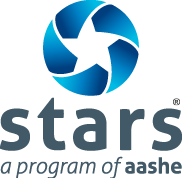| Overall Rating | Bronze - expired |
|---|---|
| Overall Score | 35.38 |
| Liaison | Rachael Rost-Allen |
| Submission Date | June 17, 2014 |
| Executive Letter | Download |
Johnson County Community College
OP-8: Building Energy Consumption
| Status | Score | Responsible Party |
|---|---|---|

|
3.32 / 6.00 |
Kristy
Howell Sustainability Education and Engagement Coordinator Center for Sustainability |
"---"
indicates that no data was submitted for this field
Total building energy consumption, all sources (transportation fuels excluded):
| Performance Year | Baseline Year | |
| Total building energy consumption | 102,008.52 MMBtu | 124,585.64 MMBtu |
Purchased electricity and steam:
| Performance Year | Baseline Year | |
| Grid-purchased electricity | 102,008.52 MMBtu | 124,585.64 MMBtu |
| District steam/hot water | 0 MMBtu | 0 MMBtu |
Gross floor area of building space::
| Performance Year | Baseline Year | |
| Gross floor area | 1,771,828 Gross square feet | 1,771,828 Gross square feet |
Floor area of energy intensive space, performance year::
| Floor Area | |
| Laboratory space | 0 Square feet |
| Healthcare space | 0 Square feet |
| Other energy intensive space |
Degree days, performance year (base 65 °F)::
| Degree days (see help icon above) | |
| Heating degree days | 4,053 |
| Cooling degree days | 1,956 |
Source-site ratios::
| Source-Site Ratio (see help icon above) | |
| Grid-purchased electricity | 3.14 |
| District steam/hot water | 1.20 |
Start and end dates of the performance year and baseline year (or 3-year periods)::
| Start Date | End Date | |
| Performance Year | July 1, 2011 | June 30, 2012 |
| Baseline Year | July 1, 2007 | June 30, 2008 |
A brief description of when and why the building energy consumption baseline was adopted:
We chose our energy consumption baseline because FY2008 happened to be the last year JCCC added a significant amount of building square footage to campus and also prior to any major campus energy efficiency efforts being made.
A brief description of any building temperature standards employed by the institution:
Our building automation system has temperature setback programming that automatically alters building setpoints based on time of day and occupancy.
A brief description of any light emitting diode (LED) lighting employed by the institution:
We have completed LED lighting retrofits where feasible including stairwells and some outdoor lighting. We completed a lighting retrofit to T8 fluorescent fixtures relatively recently and will continue to evaluate the financial feasibility of retrofitting to LEDs as market prices continue to decrease.
A brief description of any occupancy and/or vacancy sensors employed by the institution:
We utilize motion sensors in classrooms, restrooms, and various storage closets across campus.
A brief description of any passive solar heating employed by the institution:
---
A brief description of any ground-source heat pumps employed by the institution:
---
A brief description of any cogeneration technologies employed by the institution:
---
A brief description of any building recommissioning or retrofit program employed by the institution:
---
A brief description of any energy metering and management systems employed by the institution:
We have an Invensys building automation system that allows us to view and control energy, mechanical, lighting and temperature data in realtime. Energy use data is available on a per building basis. Temperature data can be viewed with detail down to the individual room level.
A brief description of the institution's program to replace energy-consuming appliances, equipment and systems with high efficiency alternatives:
---
A brief description of any energy-efficient landscape design initiatives employed by the institution:
---
A brief description of any vending machine sensors, lightless machines, or LED-lit machines employed by the institution:
Vending machines on the JCCC campus have a low-power saving mode.
A brief description of other energy conservation and efficiency initiatives employed by the institution:
---
The website URL where information about the institution’s energy conservation and efficiency initiatives is available:
---
Data source(s) and notes about the submission:
---
The information presented here is self-reported. While AASHE staff review portions of all STARS reports and institutions are welcome to seek additional forms of review, the data in STARS reports are not verified by AASHE. If you believe any of this information is erroneous or inconsistent with credit criteria, please review the process for inquiring about the information reported by an institution or simply email your inquiry to stars@aashe.org.
